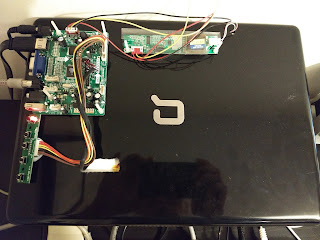 |
| Real Hardware - no emulation here... |
This laptop got thrown into a bag and forgotten until a couple of years ago. I wondered if I could use the screen somehow on my Raspberry Pi. To cut a long story short, yes, yes I can. It requires a couple of relatively inexpensive circuit boards and a bit of hacking at the screen but nothing too complicated.
The hardest bit was getting the screen out of the laptop which required totally dismantling the whole thing. When dismantling, there is a cable called the LVDS cable (I think) which is a bit delicate. It's the one the connects the LCD to the main board. Take extra care when removing it.
There are three main bits to the driver board I bought (remember that the screen has been removed wholesale from the laptop body).
 |
| The Back of my professionally modified screen* |
First, there's the main board itself. The one I got hold of has VGA, HDMI and Composite inputs.
 |
| Main board - top view so you can see the model number |
 |
| Main board - HDMI, VGA and composite inputs |
 |
| Control board |
 |
| Inverter board - look but don't touch |
And that's basically it. I had to hack a hole in the back of the screen cover to get the backlight connector through and I drilled a few holes to mount the boards (blu-tack works fine for the control board).
DISCLAIMER - NONE OF THE INFORMATION BELOW IS INTENDED TO BE A RECOMMENDATION OR ENDORSEMENT OF ANY PRODUCT. I AM NOT RESPONSIBLE FOR YOUR ORDERS, ACTIONS OR YOU BLOWING UP YOUR CAT. THE INFORMATION IS PROVIDED IN GOOD FAITH AS AN INDICATOR OF WHAT I MANAGED TO DO. YOUR MILEAGE MAY VARY. SO THERE.
Sadly, I can't find the original listing on eBay that I bought this from as it was actually nearly two years ago when I did this (is it really that long?). They are still available in various forms though, just search for 'LCD Controller kit' and you'll see various results pop up.
A few points to note when ordering:
1) Remember to get one that includes the inverter board. Without it the backlight won't work.. I'd expect to pay around £25 (around $35 ish) for a complete kit.
2) Find out the make/model of the LCD panel you have before ordering. If in doubt, email the seller and ask if they support that particular model. Most LCDs have a white label on the back with this on (mine was an LG something or other).
3) Check what inputs are supported - mine does HDMI, VGA and composite which allows me to use my Amiga (composite), Raspberry Pi (HDMI) or even my work laptop (VGA). YMMV depending on which board you find.
3) Don't forget a suitable power supply!
Good luck.
No comments:
Post a Comment